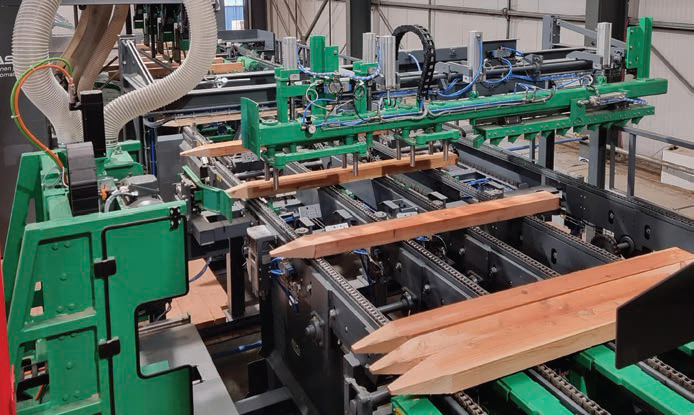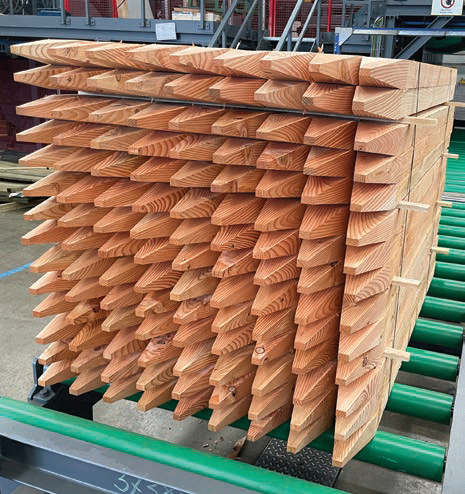Ransfords makes a point
19 October 2022Sawmiller Charles Ransford & Son’s latest investment is an automated post-pointing line, which has helped to transform the operation. Stephen Powney reports
Charles Ransford & Son proudly declares itself as a timber specialist operating since 1876.
It has a rich history as a producer of British timber products, operating on a 38-acre site at Bishops Castle in Shropshire.
During the recent period of the Covid pandemic, the business has seen exceptional demand for its range of products, which include fencing (garden, commercial, agricultural and equestrian), gates, acoustic sound panels (such as motorway fencing) and pallets and packaging.
Fencing and landscaping products represent the bulk of Ransfords’ production – 70% of this material goes to stockists, 20% to contractors and 10% to the highways segment.
The 56 employees work on a single shift and deal predominantly with redwood (60%) such as Douglas fir, with spruce accounting for the remainder.
Its most recently available annual results show a turnover of approximately £17m in 2020, with sales and demand remaining high last year.
“Since Covid, fencing and garden products significantly increased, we could almost not cut fast enough!” said Ransfords engineer Alex Cooper.
The exceptional demand seen in 2020 and 2021 has since moderated in recent months to more normal seasonal demand.
To ensure the business remains at the cutting edge, Ransfords has a policy of continuous investment, with about £20m invested in the sawmill in the past 12 years. An EWD sawing line was the largest single investment.
One of its main technology partners is German timber processing machinery specialist Kallfass.
Its relationship with Kallfass extends many years. Ransfords bought a Kallfass saw stacker 26 years ago, followed by several investments including a drop sorting system 16 years ago.
The most recent investment, completed in March 2022, was an automated post-pointing line, while a tray-sorting system for large items is currently being installed at the sawmill.
KALLFASS AUTOMATED POST-POINTING SYSTEM
The intention with the Kallfass automated post-pointing line was to increase productivity in fence and gate post production by reducing manual work. The previous manual post-pointing and feeding of the incising system had been a very time-consuming and labour-intensive manual process.
The project was first discussed between Ransfords and Kallfass about five years ago, before the Covid pandemic. At first the focus was automating the feeding process for Ransfords’ incising operations.
After Covid hit, discussions took place remotely on Microsoft Teams, but the Ransfords team was able to visit an automated post-pointing system that Kallfass had installed at A&J Scott in 2020.
“It was all on Teams – it is very beneficial to have that tool and to show Ransfords what we were able to deliver,” said Matthias Link, Kallfass sales manager. “The decision was made really fast.
“Kallfass and Ransfords have a really trustworthy relationship and that gives us the ability to do business in that way and it was a big advantage.”
“This whole project went really well despite not able to meet up, with all the meetings done remotely,” added Ransfords mechanical engineer James Davies.
Prior to the new Kallfass line, Ransfords operated a Stenner bandsaw for pointing in a manual sawing and stacking process. For gateposts, manually fed Graule cross-cut saws were used, while round-topping was completed on a small individual machine.
The new line is designed to process posts with a width of 75-200mm and length of 1.5-3m, with stacked packs being 1.2x1.2m.
It starts with a longitudinal push-off destacking with strip stripping, followed by automated feeding of an RJH Enterprise incising system.
Before incising, bad quality wood is marked manually with luminous chalk. After incising a lumi sensor on the sorting conveyor detects the coloured marked wood and opens a flap for disposal via a chute.
Then zero point alignment takes place before the post-pointing station. Four circular saws with a maximum 200mm cutting depth point the posts on all four sides, with pieces turned three times automatically between saws.
A radius milling cutting station is designed for round-topping of square or rectangular posts, complete with clamping operation. Two motors, one turning in- and one against the feed direction save the quality without tears at the edge. This station can process five to six pieces per minute.
Kallfass’ stacking system stacks sawn posts in single or multiple lengths, with automatic stick placement at a rate of five layers per minute.
The final strapping operation was a Mosca system sourced by Ransfords and integrated by Kallfass.
REDUCED MANUAL HANDLING
“In terms of the actual machines themselves,” said Mr Cooper, “it has removed massive amounts of manual handling.
“The operators don’t have to touch the wood, whereas beforehand two or three people were handling quite big pieces such as 200x200mm gateposts. All of that aspect has been removed so it is significantly safer.”
Staff have been redeployed in the new line. “We can react to orders quicker now,” added Mr Davies.
“In the past we tended to do products on an order-by-order process, but because of the way these machines work we try and batch produce and hold more in stock of the more popular products.”
Previously, the manual process to produce a four-way pointed post measuring 125x75mm would take three operators 30min to produce a pack of 126 pieces. Now it can be done in 5-10mins.
The round-topping and incising process is also now considerably quicker. It used to take two hours to complete the manual incising and round-topping process for a pack, as opposed to approximately 10mins on the Kallfass line.
The quality of finish is also important, particularly with gateposts, which are a visible feature at the entrances of properties.
“If someone is doing this cutting by hand there might be inconsistency, maybe you get a slightly different angle on each side,” said Mr Cooper. “On the new line, the machine guarantees every cut is the same.”
“Even though the pointed part [of a fence post] goes in the ground, it’s good the customer can see continuity in each pack. This can be seen when looking down the side of the pack and seeing all the points are aligned,” added Mr Davies. “That’s part of the Ransfords quality we strive to achieve.”
With the incising process, Ransfords had been unable to visit the supplier RJH during Covid restrictions, but it did visit a similar unit at James Jones & Sons to see it in action.
FURTHER INVESTMENT
The automated post-pointing line is not the only recent investment at Ransfords.
In 2018, Ransfords installed a new automated treatment facility, comprising a Stavelse high pressure autoclave and two working solutions tanks - one UC3 and the other UC4.
The autoclave operates 12 trolleys, each has a 30m3 capacity, using Wolman preservatives and is able to run 24/7.
A new biomass boiler was installed at the facility. This heats the drying area, greatly reducing the drying times of the treated products while also heating the treatment solution.
“The commissioning of the new treatment plant was timed perfectly with the increased demand over the past two years. Total automation and vastly increased capacity on each charge meant we could easily cope with large volumes of orders,” said Mr Davies.
Meanwhile, currently a further Kallfass installation is taking place at Ransfords and will be completed in October.
This is a new tray sorter process at the end of the main EWD sawmill line and before the post-pointing operation.
The tray sorter deals with large 6-8in square sections for gate posts and sleepers. The installation will feature automated stacking and cross-cutting processes. At the moment Ransfords is using a forklift to offload items, which creates a bottleneck and items are cross-cut on a small machine.
“It is a huge installation and a big investment for Ransfords,” said Mr Link.
The installation will improve Ransfords’ production time still further.
These large investment projects certainly show the company’s confidence for future business and there are likely to be some further spends to come, according to Ransfords’ purchasing director Craig Leitch.
“We are a single shift business with an annual sawn capacity of 50,000m3,” said Mr Leitch.
“There is no intention to increase output much beyond that, we’re looking for more efficient ways of doing things.
“The next significant investment here will be increasing our solar panel capacity, battery storage (if technology allows) and high-speed edging. The current edging system was installed in 2004 and that is the oldest part of the mill now, so over the next five years that may be one the changes.
“This will not be an investment to drive production output but to keep us as efficient as possible and replacing what we think needs replacing.”

